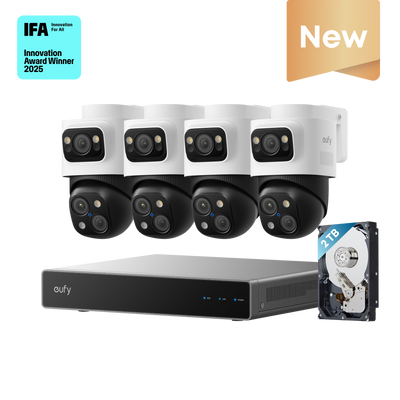If you’re wiring a new home office, setting up a gaming room, or upgrading a small business network, you’ve probably run into the Cat 6 vs 6A Ethernet cable question. At first glance, both cables look the same, but the differences can affect your internet speed, streaming quality, and how future-proof your setup will be. This guide explains what sets them apart, so you can decide whether Cat 6 is enough or if Cat 6A is the smarter investment.

What Is Cat 6?
Cat 6, short for Category 6, is a twisted-pair Ethernet cable defined in the ANSI/TIA-568.2-D standard. Introduced in the early 2000s as an upgrade over Cat 5e, it offers higher bandwidths of up to 250 MHz, as well as improved resistance to crosstalk and signal interference.
In practice, Cat 6 comfortably supports 1 Gigabit Ethernet up to 100 meters, and it can also handle 2.5 and 5 Gbps speeds (per IEEE 802.3bz) over the same distance.
When it comes to 10 Gigabit Ethernet (10 Gbps BASE-T) speeds, Cat 6 can do the job, but with limits: performance usually tops out around 55 meters, and interference in noisy environments can shorten that further.
For most home internet plans and small business networks, Cat 6 is more than enough to support activities like streaming, online gaming, and file sharing. It strikes a balance between cost and performance, making it one of the most common cable types you’ll see today.
What Is Cat 6A?
Cat 6A, where the “A” stands for Augmented, was designed as the next step up. It doubles the bandwidth to 500 MHz and adds mandatory testing for alien crosstalk, which means it’s built to resist interference from neighboring cables. The result is a cable that can reliably deliver 10 Gbps speeds across the full 100 meters, even in dense bundles or noisy electrical environments.
To achieve that, Cat 6A cables are built to tighter tolerances. Their copper conductors are twisted tighter, and they often include separators or better shielding to keep signals clean. These upgrades improve performance but also make the cables thicker and less flexible.
They’re ideal for data centers, hospitals, schools, and other spaces where long-term performance and high-capacity networks are critical. For home users, Cat 6A might feel like overkill today, but it’s becoming increasingly relevant as internet speeds climb.
Cat 6 vs Cat 6A: Key Differences
At first glance, they look almost identical, but the specifications tell a different story. The main differences between Cat 6A vs Cat 6 come down to speed, distance, noise control, shielding, and how easy each is to work with.
Speed and distance
Both Cat 6 and Cat 6A support 1 Gbps, 2.5 Gbps, and 5 Gbps across the full 100 meters of a standard channel. The real dividing line between Cat 6 vs Cat 6A cables shows up with 10 Gigabit Ethernet.
Cat 6 can run 10 Gbps, but usually only up to 37–55 meters (180 feet), depending on the amount of interference from nearby cables. Cat 6A, by contrast, is engineered to deliver 10 Gbps at the full 100 meters (328 feet), making it the stronger choice for larger or performance-critical networks.
Bandwidth
Cat 6 is rated to 250 MHz, while Cat 6A doubles that to 500 MHz. This higher frequency range gives Cat 6A more margin, particularly helpful for running 10 Gbps reliably or in electrically noisy environments.
Noise control
One of Cat 6A’s biggest advantages is noise immunity. Unlike Cat 6, Cat 6A must pass alien crosstalk tests, proving it can resist interference from adjacent cables. That’s why Cat 6A maintains 10 Gbps in dense bundles, while Cat 6 is more prone to signal degradation under the same conditions.
Shielding options
Cat 6 cables are most commonly unshielded (U/UTP), though variants with a simple foil shield (F/UTP) or individually shielded pairs (U/FTP) are also available for added protection. These options are generally sufficient in environments with minimal electrical interference.
By contrast, Cat 6A builds on this with tighter pair twists and stronger shielding choices, such as S/FTP or SF/FTP, which combine foil and braided layers around the pairs. This enhanced construction provides superior defense against both internal crosstalk and external noise, making Cat 6A especially suitable for electrically noisy settings, such as areas with fluorescent lighting, HVAC equipment, high-voltage power lines, or densely packed server racks.
Cable thickness and flexibility
Cat 6 cables are generally easier to work with, especially when running them through tight conduits, behind walls, or under floors.
Cat 6A, on the other hand, is thicker and less flexible because of its heavier copper wires and additional shielding. This makes it bulkier, with a larger bend radius, and a bit trickier to install, something worth keeping in mind for DIY setups or when working in confined spaces.
Power over Ethernet (PoE)
Both Cat 6 and Cat 6A support PoE, including IEEE 802.3bt (up to 90–100W). The difference is that Cat 6A’s heavier construction and larger conductors help it dissipate heat more effectively, which is valuable for high-power PoE devices such as access points, PoE cameras, or lighting.
Cost considerations
On average, Cat 6A costs 20–30% more than Cat 6, not just for the cable itself but also for related components like patch panels, connectors, and the extra labor or time required for installation. But the trade-off is long-term flexibility: full-length 10 Gbps support and better performance in demanding environments.
Cat 6 vs 6A vs 6e?
You may come across products labeled “Cat 6e.” Despite the familiar name, there is no official Cat 6e standard under TIA/EIA. It’s usually just marketing language for enhanced Cat 6 cable, not a recognized category like Cat 6 or Cat 6A.
Cat 6 vs Cat 6A side-by-side comparison
|
Feature |
Cat 6 |
Cat 6A |
|
Bandwidth |
250 MHz |
500 MHz |
|
1/2.5/5 Gbps reach |
100 m |
100 m |
|
10 Gbp sreach |
~37–55 m |
100 m |
|
Alien crosstalk protection |
Not required and moderate, OK for clean environments |
Required and tested, ideal for dense or noisy setups |
|
Shielding availability |
Mostly unshielded, with some F/UTP or U/FTP versions for light protection |
Commonly available with stronger shielding (S/FTP, SF/FTP) for better noise resistance |
|
Cable size |
Thinner, more flexible |
Thicker, less flexible |
|
PoE support |
Supported |
Supported, better for high-power PoE |
|
Price |
Lower, more budget-friendly |
Higher, 20–30% more on average |
|
Typical use |
Home/SMB networks, short 10 Gbp |
Enterprise, data centers, or future-proof installs needing 10 Gbp at 100 m |
Cat 6 vs 6A: When to Use Cat 6
Now, let’s bring it into real-world terms. Cat 6 works well in everyday networks where performance needs are moderate and cost-effectiveness matters.
It delivers gigabit speeds up to 100 meters, and it can also support 2.5 Gbps or 5 Gbps on modern equipment. For many homes and smaller businesses, that’s more than enough capacity.
Here are practical situations where Cat 6 makes sense:
Home internet and streaming
Most U.S. households still subscribe to internet plans under 1 Gbps, and even multi-gig plans rarely require 10 Gbps-capable wiring. Cat 6 easily handles HD and 4K streaming, video calls, smart TVs, and everyday browsing.
Gaming setups
If you’re wiring a gaming PC or console in a bedroom or living room, Cat 6 ensures low latency and stable gigabit connections. Unless you’re building a high-end gaming café or LAN room with 10 Gbps backbones, Cat 6 is plenty.
Home offices
Remote workers who rely on video conferencing, VPN connections, and cloud software will find Cat 6 fully capable. Even if you’re pushing large files, 1 Gbps or 2.5 Gbps is usually sufficient.
PoE security cameras in modest setups
If you’re wiring a handful of PoE cameras over typical residential or small-business distances, Cat 6 handles data and power cleanly while being easier to pull through soffits and ceilings.
A solid match here is the eufy PoE Turret Security Camera E41. It’s a compact 4K turret camera with a 122° field of view, adjustable head, and multiple night modes (starlight, spotlight, infrared).
You get on-camera AI detection (people, vehicles, pets, and strangers), two-way audio, warning lights, HDR, and a solid IP67 rating. It connects smoothly to the eufy NVR S4 system for 24/7 local recording, smart footage search, and remote access without a monthly bill.
{{component:"product", handle:"t8p10121", sku:"T8P10121"}}
Small offices and retail spaces
For point-of-sale terminals, VoIP phones, and general desktop connectivity, Cat 6 delivers reliable service at lower cost. If runs are short, you can still use it for some 10 Gbps uplinks between switches.
Tight cable runs and limited space
Cat 6 has a slimmer profile and bends more easily than Cat 6A. That makes it easier to snake through walls, squeeze into conduits, and terminate in crowded racks. If your project involves tight spaces, Cat 6 saves time and effort during installation.
Budget-conscious upgrades
Renovations and remodels often involve dozens of new cable drops. Choosing Cat 6 over Cat 6A lowers material and labor costs without compromising the needs of most users.
Cat 6 vs 6A: When to Use Cat 6A
Cat 6A is built for heavier-duty networks that demand speed, stability, and future-proofing. Its ability to carry 10 Gigabit Ethernet across the full 100 meters and its stronger defenses against interference make it the standard in larger or more demanding environments.
Here are practical examples of when Cat 6A is the better choice:
Enterprise networks
In large office buildings where workstations, servers, and storage devices are spread across long cable runs, Cat 6A guarantees 10 Gbps performance from end to end.
Data centers and server rooms
When switches, servers, and storage arrays must all be connected at 10 Gbps or higher, Cat 6A provides the consistency and headroom that Cat 6 can’t guarantee at scale.
Large or high-power PoE camera deployments
If you’re setting up an NVR security system with high-powered PoE cameras—like those with PTZ (pan-tilt-zoom) motors, advanced processing, multiple sensors, or 4K+ resolution—especially over long distances or in tightly bundled runs, Cat 6A’s thicker cable helps preserve image quality and power delivery without overheating.
A great fit here is the eufy PoE Bullet-PTZ Cam S4. It combines 3 lenses in one housing to cover both the big picture and close-up detail.
{{component:"product", handle:"t8e00121", sku:"T8E00121"}}
- A fixed 4K ultra-wide lenscaptures a 122° overview of the scene.
- A dual 2K PTZ modulebeneath it provides 360° motion and 8× hybrid zoom, so you can track subjects without losing context.
- Together, they deliver 16MP clarity, sharp enough to capture fine details from up to 164 feet away.
Nighttime coverage is versatile:
- Starlight colormode produces clear, natural footage in low light.
- The built-in spotlightbrightens darker areas when needed.
- Infrared modeoffers discreet, black-and-white monitoring.
Smart functions include auto-framing and group tracking, on-device AI detection (people, vehicles, pets, strangers), HDR to prevent glare, two-way audio, and warning lights. With an IP65 weather rating, it’s built for outdoor use.
When paired with another Bullet-PTZ S4, the cameras can use cross-cam AI tracking, handing off a moving subject between them, perfect for driveways, yards, or large entrances. It’s designed to work with the eufy NVR S4, which supports up to 16 channels, auto records 24/7, offers AI-powered smart keyword video search, and gives you local storage (from 2 TB up to 16 TB) without relying on the cloud.
Wireless access points (WAPs)
Modern Wi-Fi 6 and Wi-Fi 7 access points often require multi-gig uplinks and high-power PoE. Cat 6A not only supports the bandwidth but also manages heat better, making it safer for long-term PoE delivery.
Healthcare and education facilities
Hospitals and schools often need reliable 10 Gbps backbones to support digital imaging, streaming, and e-learning platforms. Cat 6A ensures a consistent network in these data-heavy environments.
Future-ready home builds
For custom homes or major renovations, installing Cat 6A ensures that the network won’t become outdated as faster internet service and multi-gig devices become more common. Even if you only need gigabit speeds today, Cat 6A avoids costly rewiring later.
Conclusion
Choosing between Cat 6 vs 6A comes down to balancing today’s needs with tomorrow’s growth. Cat 6 is flexible, affordable, and more than capable for gigabit or short 10 Gbps runs, making it ideal for homes and small offices. Cat 6A, on the other hand, guarantees 10 Gbps at 100 meters, handles interference better, and supports higher-power PoE, perfect for enterprises, large spaces, and future-proof builds. By weighing your space, budget, and long-term plans, you can confidently pick the cable that keeps your network fast, reliable, and ready for what’s ahead.
FAQs
Is Cat6a better than Cat6?
Yes, Cat6a is generally considered better if you need higher speeds or longer runs. It offers double the bandwidth (500 MHz vs. 250 MHz) and can deliver 10-Gigabit Ethernet across the full 100 meters, while Cat6 typically supports 10 Gbps only up to about 55 meters. Cat6a also reduces interference more effectively. The trade-offs are that it’s bulkier and more expensive. If you’re wiring for future-proof 10 Gbps everywhere, Cat6a makes sense; otherwise, Cat6 is usually more than enough.
Is Cat6 compatible with Cat6a?
Yes. Both Cat6 and Cat6A use standard RJ45 connectors and work together without issue. You can mix them in the same network, but the overall speed and performance will only match the lowest-rated part of the chain. For example, if you connect a Cat6 cable to Cat6A jacks, the link will perform at Cat6 levels.
What are the disadvantages of Cat6a?
The main downsides of Cat6A are its size, weight, and cost. The cables are thicker and stiffer, which means they take up more space, require wider bends, and can be trickier to install, especially in tight spaces or during retrofits. They’re also heavier and more expensive than Cat6.
Is Cat6 overkill for home use?
Not at all, Cat6 is actually an ideal choice for modern homes that stream 4K content, use smart devices, or require low-latency gaming. It easily supports 1 Gbps up to 100 meters, can handle 2.5 or 5 Gbps with newer NBASE-T equipment, and even reaches 10 Gbps over shorter runs. For typical home networking, Cat6 strikes a great balance of speed, cost, and flexibility.















